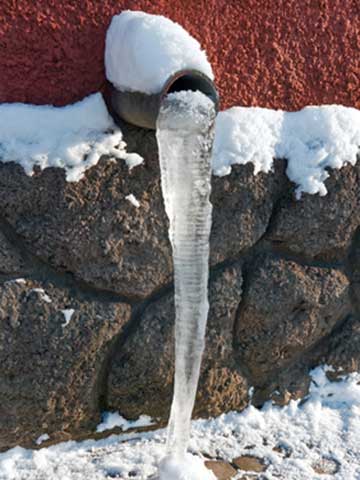
Winterizing your home’s plumbing is an important part of home ownership. Keeping your pipes from freezing will help you to prevent burst pipes, damage to your property and belongings and frankly, will save you money and time in the springtime when everything thaws out!
You can help to prevent your pipes from freezing by doing the following…
- For pipes in your garage walls, keep your garage doors closed to retain as much heat as you can inside your garage.
- Open the kitchen and bathroom cabinets (in case there are any pipes behind those cabinets). This is especially helpful during the evening when temperatures can go below 20 degrees Fahrenheit.
- Turn a faucet on so that water drips (leave it on while the temperature is 20 degrees or lower). This forces water to run through the pipes and helps to prevent sitting water from freezing.
- Keep your thermostat at the same temperature during the day and night.
- Any insulation that you can add to your home, in the walls, wrapping pipes, windows, cracks in doors, etc. will help to prevent your water pipes from bursting and creating an expensive mess.
When Should You Wrap Your Pipes?
Your water pipes can freeze when the temperature gets below freezing so the best time to wrap your pipes is before that temperature drops. We recommend that you wrap your pipes several hours prior to the temperature drop.
Using electrical heat tape, foam rubber insulation, pipe sleeves or other insulation products that you can purchase at your local hardware store are what is recommended to help protect your pipes from freezing.
Should I Drain My Pipes To Keep Them From Freezing?
Outdoor hoses and hose bibs must be drained to keep them from freezing. After hoses are drained they should be stored in your garage.
To winterize your hose bibs…
- Locate the shut off valve for your exterior hose bibs. This is usually in the garage of most homes normally close to the outdoor faucet of your home.
- Turn off this shut off valve.
- Remove any hoses that are attached to the hose bib and as we stated earlier, store them away for the winter.
- Turn on your outdoor faucet all the way so that any remaining water in those pipes is released. Let it drip for about 1 minute until you are sure that all the water is out.
- Turn off your outdoor faucet once the water has all been released.
- Go the extra mile and use any of the products available today to cover your hose bib for the winter OR you can upgrade your faucet to a frost proof model.
Should I Let My Faucet Drip In Cold Weather?
Yes, this is one tactic that works very well to help keep your pipes from freezing. Following are our recommendations on how to best us it…
- Choose a faucet in your home that is the furthest away from your water heater. So, this could be a bathroom upstairs or perhaps in your basement.
- When the temperature drops below 20 degrees Fahrenheit which here in the Atlanta, Ga. area is often during the evening turn the cold water on just slightly so that water drips from it. This keeps the water supply running through the plumbing system helping to prevent it from freezing.
- When the temperature rises above 20 degrees you can then turn the dripping faucet off.
Will Pipes Freeze In An Unheated Basement?
If the temperature in the unheated basement (or attic or garage or any part of your home that is unheated) reaches freezing (20 degrees Fahrenheit) then yes, your pipes can certainly freeze.
If you cannot keep the area warm then we recommend that you wrap the pipes in some form of insulation as we mentioned above and of course, cover any holes or areas that allow cold air from the outdoors to come in. Make sure to check all your exterior doors and windows (if any) in the basement area for these leaks.
If you have any questions about winterizing your plumbing system or are having some problems with it, call Atlantis Plumbing today at 770-505-8570. We are available 24 hours a day, 7 days a week.